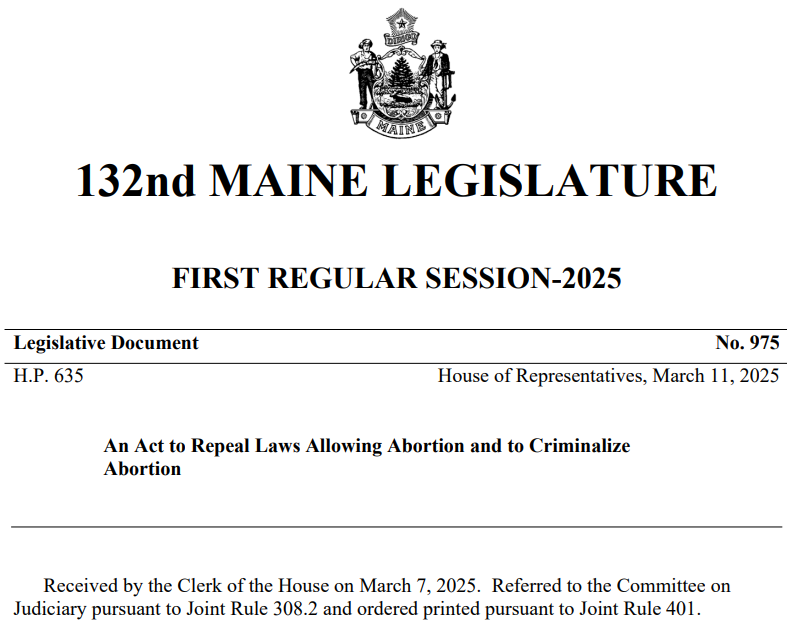On Friday March 28 of 2025, members of the theater group of The Audacity traveled from their various home towns of the midcoast to the Maine State House in Augusta, donned the red robes and white bonnets that visually refer to Margaret Atwood’s The Handmaid’s Tale, and stood outside the hearing room where the Judiciary Committee of the Maine State Legislature received testimony regarding L.D. 975 and other bills that would outlaw and criminalize abortion in the state of Maine. The visual testimony of this group augmented the written transcript of testimony by 34 members of The Audacity submitted to the public record for the same hearing. Multiple members of the theater group had lived through a time in American history during which abortion had been criminalized and women punished for making choices about their own bodies.

Participant Lisa Kushner arrived alone:
“I attended that event dressed in a red costume. When I walked up outside the statehouse there were 2 small groups of people, anti abortion Christians and pro abortion supporters. Those against the bills were loudly chanting slogans like ‘my body my choice’. There were more young people than I’d seen at other demonstrations. I joined another red cloaked person who was there on her own. I was looking for The Audacity group but didn’t know where they were meeting up.
After about 15 minutes the red cloaked white bonnet maidens came from the Cross building in single file through both groups of protesters. A silence occurred. It was a dramatic moment.
The red tape covering their mouths was really effective.”
Nancy Davis describes the day:
“I was part of the handmaid‘s group who went to Augusta on Friday. We met outside the Cross building a little after nine, finished getting our red outfits on and strolled through the building to the capital. We were a big stand out in the crowd as we approach the capital building. Lots of people took our picture and news crews filmed us entering the building. unfortunately, the hearing was in a small room and couldn’t accommodate groups of people. People who wished to speak, had to sign in, declare if they were in favor or opposed to the law and wait their turn to speak one by one. Of course they chose the people who were opposed to abortion go first. So we stood for a couple of hours waiting and still realized we had a long time to go so most people left to go home. Three of us were interviewed by Channel 8 news. However, I watched, and unfortunately, only one of us was quoted and in just a few words. I was the only one filmed in the story, although the two women with me were much more articulate than I.”
Kimberly Krejsa adds:
“We gathered together in a cold, windy parking garage. Looking furtively around, we quickly put on our disguises; red gowns, white bonnets. Briskly, we walked to the rendezvous point, gathering more maidens as we approached the government building. Protesters gathered outside, yelling and chanting at each other; cameras were turned in our direction as we solemnly walked into the building. We were recognized and warmly greeted by several folks. We could hear people murmuring about our costumes as we walked about, silently protesting the extremity of these 7 bills. People signed up to argue their case, one by one, in front of the legislative committee. Passions were high, arguments were eloquent and the committee was patient and kind. Everyone had a chance to speak if they did not mind waiting for hours. Some of the personal testimony was heart-breaking as people shared their personal stories. It was good trouble.”

Cynthia Stancioff concludes:
“We were sort of struggling with costumes in the wind, not all that unified in appearance, and without any choreography of our movements. So I think we looked like a small group of distinctly-dressed, mostly-old ladies (one childbearing age person among us), there to make an impression – but doing nothing in particular. It was clear some people recognized the trope, but there wasn’t news coverage as far as I could tell, so we impressed a hundred people or so? Maybe I missed a tv camera or something though.
“I felt like we needed some plan (marching orders, as it were) of how to walk around, like single file, heads down, – didn’t have to be fancy to be dramatic, but we didn’t take advantage of the theatrical possibilities! A fair number of people did take pictures of us, and we met with only approval, no opposition that I could see.”

